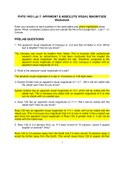Other
PHYS 1403 Lab 7: APPARENT & ABSOLUTE VISUAL MAGNITUDE Worksheet | Collin college
- Course
- Institution
When completing this exam, did you comply with Walden University’s Code of Conduct including the expectations for academic integrity? The PMHNP understands that slow-dose extended release stimulants are most appropriate for which patient with ADHD? Jordan is diagnosed with obsessive compulsiv...
[Show more]



